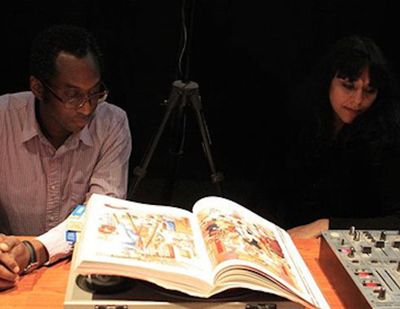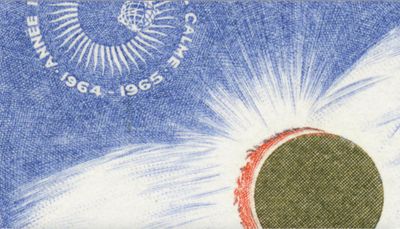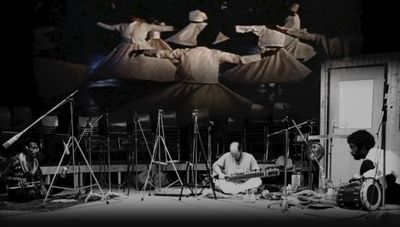Categories
- Amitesh Shrivastava
- Amol K Patil
- Anupam
- Ashwini Bhat
- Baptist Coelho
- Chirodeep Chaudhuri
- Desire Machine Collective
- Goutam Ghosh
- Hemali Bhuta
- Himali Singh Soin
- Huma Mulji
- Khageshwar Rout
- Khageswar Rout
- Mahesh Baliga
- Munem Wasif
- Neha Choksi
- Pallavi Paul
- Prajakta Potnis
- Prasad Shetty & Rupali Gupte
- Raqs Media Collective
- Risham Syed
- Rohini Devasher
- Sandeep Mukherjee
- Sarnath Banerjee
- Shreyas Karle
- Shumon
- Tejal Shah
- The Otolith Group
- Uncategorized
Ocula: The Otolith Group’s Science Fiction of the Present

In the context of an expansive practice that weaves archival and contemporary images and sounds, The Otolith Group blends poetry and fiction with the documents of lived histories to conceptualise speculative, inclusive futures and languages of becoming.
The artist collective and non-profit organisation was founded in 2002 by artists and theorists Anjalika Sagar and Kodwo Eshun, who operate across the fields of research, art-making, performance, writing, curation, and discursive programming to explore vital political legacies that continue to haunt the present.
 The Otolith Group, In the Year of the Quiet Sun (2013). 16:9 H.D. video installation with colour and sound, digital scans, archival film, projection wall, seating. 33 min, 57 sec. Exhibition view: Xenogenesis, Sharjah Art Foundation (13 November 2021–6 February 2022). Courtesy Sharjah Art Foundation. Photo: Shanavas Jamaluddin.
The Otolith Group, In the Year of the Quiet Sun (2013). 16:9 H.D. video installation with colour and sound, digital scans, archival film, projection wall, seating. 33 min, 57 sec. Exhibition view: Xenogenesis, Sharjah Art Foundation (13 November 2021–6 February 2022). Courtesy Sharjah Art Foundation. Photo: Shanavas Jamaluddin.
Video essays like In the Year of the Quiet Sun (2013) and Nucleus of the Great Union (2018) look at Pan-Africanism through the lens of an arrested futurism, confronting a contradictory sense of disillusionment and hope that is reflected in the non-aligned images and perspectives the collective translates into video essays woven through with tapestries of sound.
‘We looked at the Bandung and Pan-African moment through a post-disillusionment lens because we were born after,’ Sagar and Eshun explain.
Born in 1968 and 1966 respectively, both artists are of transcultural heritage and grew up in London at a time defined as much by the racism of Enoch Powell as by the radical politics of Stuart Hall and the Black British Arts movement. They met in 2001 just after the 11 September attacks on the World Trade Center in New York.
In this interview, the collective talk about approaching the histories of Pan-Africanism, and beyond that, of Non-Alignment and Third Worldism, ‘from the end backwards, and through a certain kind of received pessimism’.
Nucleus of the Great Union, for example, recovers the unpublished photographic archive of Black American novelist Richard Wright, shot during his first trip to Africa in 1953, where he witnessed the rise of Kwame Nkrumah’s Convention People’s Party, West Africa’s first mass socialist party, as it campaigned for independence against British rule.
These photographs were to be included in Wright’s text Black Power: A Record of Reactions in a Land of Pathos (1954), which addressed the author’s ‘existential alienation from the Gold Coast’, and challenged the concept of racial belonging and Pan-African politics by invoking a Fanonian view of class, and the implications of colonised elites unable to break free from structures of colonial power.
 The Otolith Group, In the Year of the Quiet Sun (2013) (still). Video, colour, sound: stereo. 33 min, 57 sec. © The Otolith Group. Courtesy the artists.
The Otolith Group, In the Year of the Quiet Sun (2013) (still). Video, colour, sound: stereo. 33 min, 57 sec. © The Otolith Group. Courtesy the artists.
Similarly, In the Year of the Quiet Sun, whose title refers to the phenomenon of the solar surface temperature cooling every 11 years, explores the contradictions of post-independence politics in Ghana.
The film focuses on magnified details of postage stamps, maximising their iconoclasm to zoom in on the political ceremony of independence, and the making and unmaking of polity on a continental scale. What is revealed is political instability on the ground: military coups against governments in Nigeria and Ghana, uprisings in Zanzibar, and a crisis of sovereignty in Congo.
Other works look beyond the nation-state to explore histories of transnationalism at a human scale. Created from solarised and colourised black-and-white photographs, the video essay People to be Resembling (2012) effectively presents a concrete methodology for togetherness located in the band Codona, founded in 1978 by three musicians from different cultures: Collin Walcott, Don Cherry, and Naná Vasconcelos.
‘For us, Codona stands as a scale model for a sonic ecology or philosophy,’ The Otolith Group explains. ‘We wanted to evoke that through these photographs—to make music the substance of the work, not just its subject.’
 The Otolith Group, People to be Resembling (2012) (still). Video, colour, sound. 21 min, 42 sec. © The Otolith Group. Courtesy the artists.
The Otolith Group, People to be Resembling (2012) (still). Video, colour, sound. 21 min, 42 sec. © The Otolith Group. Courtesy the artists.
People to be Resembling and In the Year of the Quiet Sun are among the works included in the travelling exhibition Xenogenesis, which unfolds at its final destination, the Irish Museum of Modern Art (IMMA) in Dublin, from 7 July 2022 to 12 February 2023, after launching at the Van Abbemuseum, Eindhoven, in 2019.
In 2020, the show, which was curated by IMMA director Annie Fletcher, travelled to Buxton Contemporary, Melbourne; Institute for Contemporary Art at Virginia Commonwealth University, Richmond; and Southern Alberta Art Gallery, Lethbridge. In November 2021, an iteration of the show opened at the Sharjah Art Foundation, co-curated by Hoor Al Qasimi, before opening at the Museum of Contemporary Art Metelkova, Ljubljana, in 2022.